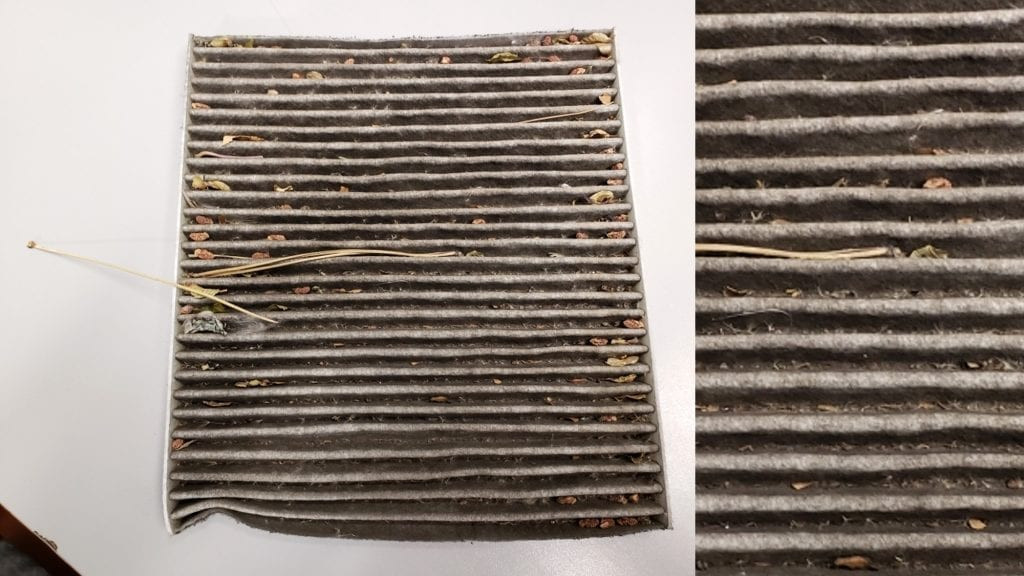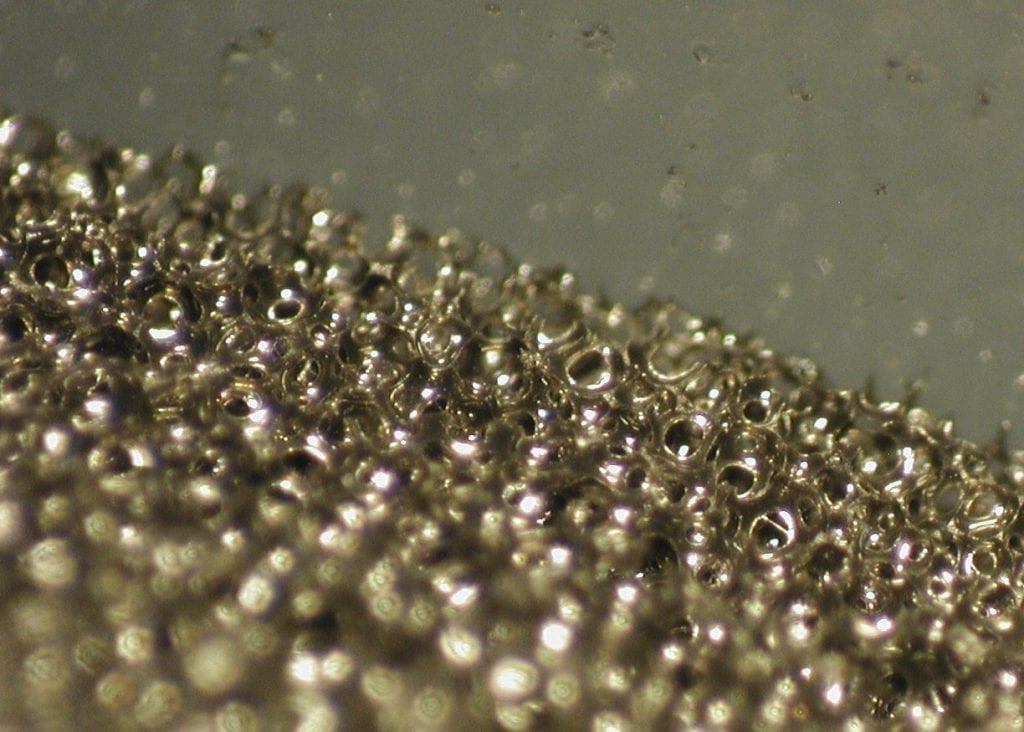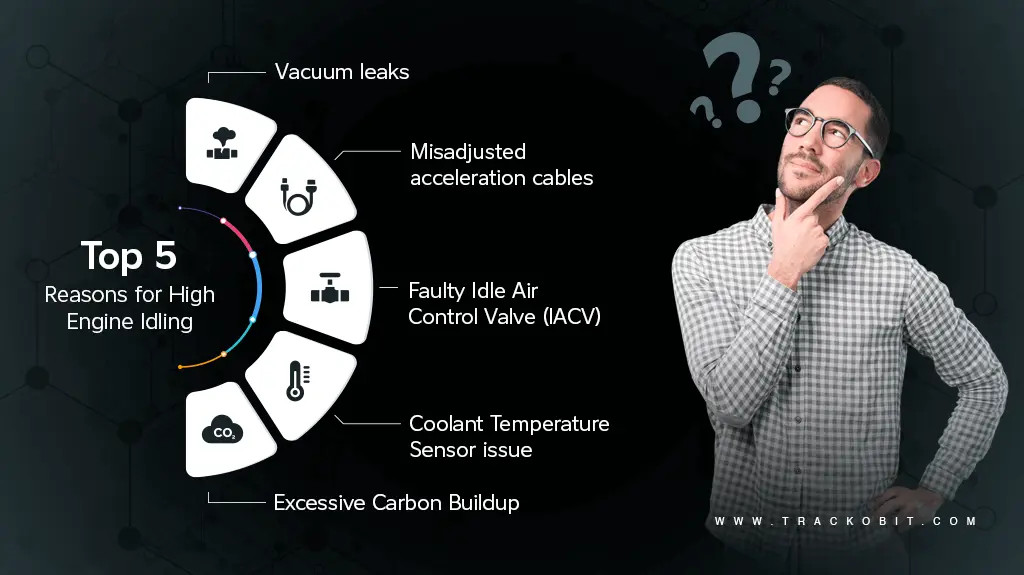How To Fix AC Smell In Car: A Comprehensive Guide

Is your car AC emitting an unpleasant odor? Don’t worry; CARDIAGTECH.NET is here to help you diagnose and eliminate that musty, mildewy, or otherwise offensive smell. This comprehensive guide will walk you through the causes of car AC smells and provide effective solutions to restore fresh, clean air to your vehicle. Read on to discover practical tips for AC maintenance and odor removal, ensuring a healthier and more enjoyable driving experience with air conditioning cleaning, evaporator cleaning and ventilation system maintenance.
1. Understanding the Culprits Behind Car AC Odors
The first step in fixing that unpleasant smell is understanding what’s causing it. Several factors can contribute to foul odors emanating from your car’s AC system.
1.1. Mold and Mildew Growth
Moisture accumulation within the AC system creates an ideal environment for mold and mildew to thrive. When the air conditioning is running, the evaporator coil cools down, causing condensation. If this moisture doesn’t drain properly, it can lead to mold and mildew growth on the evaporator and surrounding components. According to the Environmental Protection Agency (EPA), mold can grow on virtually any substance where moisture is present.
 Mold growth on a car AC evaporator
Mold growth on a car AC evaporator
This image illustrates how a dirty air filter can trap moisture and debris, creating a breeding ground for mold and contributing to unpleasant smells in your car’s AC system.
1.2. Bacteria and Microorganism Buildup
In addition to mold and mildew, bacteria and other microorganisms can also contribute to unpleasant odors. These organisms thrive in damp, dark environments and can colonize the evaporator core, air ducts and other components of the AC system. A study published in the journal “Applied and Environmental Microbiology” found that car AC systems can harbor a diverse range of bacteria, including some that are potentially harmful to human health.
1.3. Trapped Debris and Contaminants
Leaves, dirt, pollen and other debris can enter the AC system through the exterior air vents. Over time, this debris can accumulate on the evaporator coil and in the air ducts, providing a food source for mold, mildew and bacteria. Additionally, contaminants like cigarette smoke, pet dander and spilled food can also contribute to unpleasant odors.
1.4. Refrigerant Leaks
While less common, refrigerant leaks can also cause unusual smells in the car. Refrigerant has a distinct, slightly sweet odor that some people find unpleasant. If you suspect a refrigerant leak, it’s essential to have your AC system inspected and repaired by a qualified technician.
2. Identifying the Specific Type of Car AC Smell
Different types of odors can indicate different problems within the AC system. Here’s a breakdown of common car AC smells and their potential causes:
2.1. Musty or Mildewy Smell
This is the most common type of car AC smell and is typically caused by mold and mildew growth on the evaporator coil. The musty odor is often strongest when you first turn on the AC and may diminish as the system runs.
2.2. Rotten Egg Smell
A rotten egg smell often indicates a sulfur-like odor, which can be caused by a malfunctioning catalytic converter or a failing battery. While this smell may not be directly related to the AC system, it can be drawn into the cabin through the vents.
2.3. Vinegar Smell
A vinegar smell can be caused by bacteria growth in the AC system. This type of odor is often accompanied by a sour or acidic scent.
2.4. Burning Smell
A burning smell can indicate a variety of problems, including a failing blower motor, a short circuit in the electrical system, or a refrigerant leak. If you notice a burning smell, it’s essential to have your car inspected by a qualified technician as soon as possible.
2.5. Chemical Smell
A chemical smell can be caused by a refrigerant leak or the presence of other chemicals in the AC system. If you suspect a refrigerant leak, it’s essential to have your car inspected and repaired by a qualified technician.
3. Step-by-Step Guide to Fixing Car AC Smells
Now that you have a better understanding of the causes of car AC smells, let’s dive into the step-by-step guide to fixing the issue.
3.1. Gather Your Supplies
Before you begin, gather the following supplies:
- AC vent cleaner
- Foam cleaner for AC evaporator
- New cabin air filter (if applicable)
- Gloves
- Safety glasses
- Screwdrivers
- Wrench set
- Vacuum cleaner with hose attachment
3.2. Locate and Inspect the Cabin Air Filter
The cabin air filter is responsible for filtering the air that enters the car’s cabin through the AC system. A dirty or clogged cabin air filter can restrict airflow and contribute to unpleasant odors. Consult your car’s owner’s manual to locate the cabin air filter. Once you’ve located it, remove the filter and inspect it for dirt, debris and signs of mold or mildew growth.
3.3. Replace the Cabin Air Filter
If the cabin air filter is dirty or clogged, replace it with a new one. Be sure to install the new filter in the correct orientation, as indicated by the arrows on the filter frame. Replacing the cabin air filter is a simple and inexpensive way to improve the air quality in your car and reduce unpleasant odors.
3.4. Clean the AC Vents
Use an AC vent cleaner to disinfect and deodorize the air vents. Spray the cleaner into the vents and allow it to sit for the recommended time, then wipe away any excess cleaner with a clean cloth. This will help to kill bacteria and mold that may be lurking in the vents.
3.5. Clean the Evaporator Core
The evaporator core is a key component of the AC system and is a common breeding ground for mold and mildew. To clean the evaporator core, use a foam cleaner specifically designed for this purpose. Follow the instructions on the cleaner to apply it to the evaporator core. In most cases, you’ll need to insert the cleaner’s nozzle into the evaporator drain and spray the foam into the core. The foam will expand and kill mold and mildew, then drain out of the system.
3.6. Inspect and Clean the Evaporator Drain
The evaporator drain is responsible for removing condensation from the AC system. If the drain is clogged, moisture can accumulate in the system and lead to mold and mildew growth. Locate the evaporator drain and inspect it for clogs. You can use a piece of wire or a pipe cleaner to clear any blockages. Once the drain is clear, flush it with water to remove any remaining debris.
3.7. Run the AC System
After cleaning the AC system, run it on high for at least 10 minutes to circulate fresh air through the vents. This will help to dry out any remaining moisture and eliminate any lingering odors.
3.8. Disinfect the Interior
If the unpleasant odor persists, consider disinfecting the entire interior of your car. Use a disinfectant spray or wipes to clean all surfaces, including the dashboard, seats, carpets and headliner. Pay special attention to areas that may have come into contact with moisture or contaminants.
4. Professional AC Cleaning Services
If you’ve tried the DIY methods and your car AC still smells bad, it may be time to seek professional help. A qualified mechanic can perform a more thorough cleaning of the AC system and identify any underlying problems that may be contributing to the odor.
4.1. AC System Flush
An AC system flush involves using specialized equipment to remove all of the old refrigerant, oil and contaminants from the system. This process can help to eliminate unpleasant odors and improve the overall performance of the AC system.
4.2. Evaporator Core Replacement
In severe cases of mold and mildew growth, it may be necessary to replace the evaporator core. This is a more expensive repair, but it can be the only way to completely eliminate the odor.
4.3. Ozone Treatment
Ozone treatment involves using an ozone generator to produce ozone gas, which is a powerful oxidizing agent that can kill mold, mildew and bacteria. The ozone gas is circulated through the car’s interior for a set period, then the car is ventilated to remove any remaining ozone.
5. Preventing Future Car AC Smells
Once you’ve eliminated the unpleasant odor from your car’s AC system, it’s important to take steps to prevent it from returning. Here are some tips for preventing future car AC smells:
5.1. Use AC Sparingly
Overuse of the AC system can lead to excessive moisture buildup, which can promote mold and mildew growth. Try to use the AC sparingly and only when necessary.
5.2. Turn off AC Before Shutting off Car
A few minutes before you reach your destination, turn off the AC but leave the fan running. This will help to dry out the evaporator core and prevent moisture buildup.
5.3. Use Recirculation Mode
When using the AC, use the recirculation mode to prevent outside air from entering the system. This will help to reduce the amount of moisture and contaminants that enter the AC system.
5.4. Park in the Shade
Parking your car in the shade can help to reduce the temperature inside the car and reduce the need to use the AC.
5.5. Regular Maintenance
Regular maintenance is essential for keeping your car’s AC system in good condition. This includes replacing the cabin air filter regularly, inspecting the evaporator drain for clogs and having the system inspected by a qualified mechanic.
 Car AC maintenance
Car AC maintenance
This image showcases antimicrobial-treated foam used in car AC systems, effectively inhibiting mold growth and preventing musty odors.
6. The Importance of Quality Air Conditioning Tools
Maintaining a car’s AC system, whether for odor removal or general upkeep, requires the right tools. CARDIAGTECH.NET understands this need and offers a comprehensive range of high-quality tools specifically designed for automotive AC maintenance. Here’s why investing in quality tools is crucial:
6.1. Efficiency and Precision
Quality AC tools are engineered for efficiency and precision, allowing technicians to perform tasks quickly and accurately. This translates to faster turnaround times and reduced labor costs.
6.2. Durability and Reliability
Professional-grade tools are built to withstand the rigors of daily use in a demanding shop environment. They are made from durable materials and designed for long-lasting reliability, ensuring a solid return on investment.
6.3. Safety
Working with AC systems involves handling refrigerants and other potentially hazardous materials. Quality tools are designed with safety in mind, providing features like pressure relief valves and secure connections to minimize the risk of accidents and injuries.
6.4. Comprehensive Solutions
CARDIAGTECH.NET offers a wide range of AC tools to address every aspect of system maintenance, from leak detection and refrigerant recovery to component replacement and performance testing.
6.5. Enhanced Customer Satisfaction
By using quality tools, technicians can deliver superior service and ensure customer satisfaction. This can lead to repeat business and positive word-of-mouth referrals.
7. CARDIAGTECH.NET: Your Partner in Automotive AC Solutions
At CARDIAGTECH.NET, we are committed to providing our customers with the highest quality automotive AC tools and equipment. We offer a wide range of products from leading brands, all backed by our expert support and service. Here’s what sets us apart:
7.1. Extensive Product Selection
We offer a comprehensive selection of AC tools, including:
- Refrigerant recovery machines
- Leak detectors
- Vacuum pumps
- Manifold gauge sets
- Charging stations
- UV leak detection kits
- AC system flush kits
- Compressor service tools
- Evaporator core cleaners
7.2. Expert Support and Service
Our team of experienced technicians is available to provide expert support and service. We can help you select the right tools for your needs, troubleshoot problems and provide training on how to use the equipment safely and effectively.
7.3. Competitive Pricing
We offer competitive pricing on all of our products, ensuring that you get the best value for your money.
7.4. Fast Shipping
We offer fast shipping on all orders, so you can get the tools you need quickly and efficiently.
7.5. Customer Satisfaction Guarantee
We stand behind our products and services with a customer satisfaction guarantee. If you’re not happy with your purchase, simply return it for a full refund.
8. Real-World Examples of Car AC Smell Solutions
To illustrate the effectiveness of the methods discussed, here are a couple of real-world examples:
8.1. Case Study 1: Musty Smell in a Honda Civic
A customer complained of a persistent musty smell in their 2015 Honda Civic. After inspecting the cabin air filter, it was found to be heavily contaminated with mold and debris. The filter was replaced, and the AC evaporator core was cleaned using a foam cleaner. The evaporator drain was also cleared of a minor blockage. After these steps, the musty smell was completely eliminated.
8.2. Case Study 2: Vinegar Smell in a Toyota Camry
A customer reported a vinegar smell in their 2018 Toyota Camry. The AC system was inspected, and it was determined that bacteria growth was the likely cause. An AC system flush was performed, and the interior of the car was disinfected. This resolved the vinegar smell and improved the overall air quality in the car.
9. Statistics and Data on Car AC Problems
Here are some statistics and data points that highlight the prevalence of car AC problems and the importance of regular maintenance:
- According to a survey by the Car Care Council, 17% of vehicles have AC systems that are not functioning properly.
- The most common AC problems include refrigerant leaks, compressor failures and clogged cabin air filters.
- The average cost to repair a car AC system is $500-$1,000.
- Regular AC maintenance can extend the life of the system and prevent costly repairs.
10. Call to Action: Get Your AC Tools Today
Don’t let a smelly car AC ruin your driving experience. Take action today to eliminate unpleasant odors and restore fresh, clean air to your vehicle.
10.1. Contact CARDIAGTECH.NET for Expert Advice
If you’re unsure which AC tools are right for your needs, contact the experts at CARDIAGTECH.NET. They can provide personalized recommendations and help you select the perfect tools for your budget and skill level. Reach out to them for advice on maintaining your AC system and discover the best tools to keep your car smelling fresh and clean. You can reach CARDIAGTECH.NET at 276 Reock St, City of Orange, NJ 07050, United States. Whatsapp: +1 (641) 206-8880. Or visit our website: CARDIAGTECH.NET
10.2. Browse Our Extensive Selection of AC Tools
Visit CARDIAGTECH.NET today to browse our extensive selection of AC tools. We offer a wide range of products from leading brands, all at competitive prices.
10.3. Order Online for Fast Shipping
Order your AC tools online today and enjoy fast shipping. We’ll get your order to you quickly so you can start eliminating those unpleasant odors and enjoying a fresher, cleaner driving experience.
By investing in quality AC tools and following the tips in this guide, you can keep your car’s AC system in top condition and enjoy a comfortable and odor-free driving experience.
11. How to Choose the Right AC Vent Cleaner
Selecting the appropriate AC vent cleaner is essential for effectively eliminating odors and ensuring a healthy environment inside your vehicle. Here’s what to consider:
- Type of Cleaner: AC vent cleaners come in various forms, including sprays, foams, and wipes. Sprays are easy to apply and reach into vents, while foams expand to fill and clean the entire vent system. Wipes are suitable for surface cleaning.
- Ingredients: Look for cleaners with antimicrobial and antibacterial properties to kill mold, mildew, and bacteria. Ensure the ingredients are safe for your car’s interior and won’t damage surfaces.
- Scent: Choose a cleaner with a pleasant, mild scent to freshen the air without being overpowering. Avoid products with strong chemical odors.
- Ease of Use: Opt for cleaners that are easy to apply and require minimal effort. Follow the product instructions carefully for the best results.
- Reviews and Recommendations: Check online reviews and seek recommendations from other car owners to find reliable and effective AC vent cleaners.
12. Understanding Refrigerant Types and Safety
Working with refrigerants requires a thorough understanding of the different types and the safety precautions necessary to handle them. Here’s an overview:
| Refrigerant Type | Description | Safety Precautions |
|---|---|---|
| R-134a | A common hydrofluorocarbon (HFC) refrigerant used in many vehicles. | Wear safety glasses and gloves, ensure proper ventilation, and avoid skin contact. |
| R-1234yf | A newer hydrofluoroolefin (HFO) refrigerant with a lower global warming potential. | Follow manufacturer’s guidelines, use proper recovery equipment, and ensure technicians are certified. |
| CO2 (R-744) | Carbon dioxide is an environmentally friendly refrigerant used in some modern systems. | Handle with care, use high-pressure equipment, and ensure the system is designed for CO2. |
| R-22 | An older hydrochlorofluorocarbon (HCFC) refrigerant being phased out due to its ozone-depleting properties. | Requires special certification to handle, avoid venting into the atmosphere, and use recovery systems to reclaim the refrigerant. |
| Ammonia (R-717) | Used in some industrial AC systems. | Requires specialized training, proper ventilation, and strict safety protocols due to its toxicity and flammability. |
| Propane (R-290) | An environmentally friendly refrigerant that is flammable. | Requires specialized equipment and training, proper ventilation, and adherence to strict safety regulations to prevent fire and explosion hazards. |
Always follow the manufacturer’s guidelines and local regulations when handling refrigerants. Proper training and certification are essential for working with these substances safely.
13. Common Mistakes to Avoid When Cleaning Your Car AC
To ensure effective cleaning and prevent damage to your AC system, avoid these common mistakes:
- Using Household Cleaners: These can be too harsh and damage AC components.
- Ignoring the Cabin Air Filter: Replace it regularly to prevent debris buildup.
- Overlooking the Evaporator Drain: Keep it clear to prevent moisture accumulation.
- Neglecting Safety Precautions: Always wear protective gear.
- Skipping Professional Help: For persistent issues, consult a mechanic.
14. Addressing Specific Car AC Smell Scenarios
Different situations may require tailored approaches to eliminate car AC smells. Here are some specific scenarios and their solutions:
14.1. AC Smells After Rain
- Problem: Rainwater can seep into the AC system, creating a breeding ground for mold and mildew.
- Solution: Dry out the system by running the AC on high with the windows open. Use an AC vent cleaner to disinfect the vents and consider a professional AC system flush.
14.2. AC Smells When First Turned On
- Problem: This often indicates mold and mildew growth on the evaporator coil.
- Solution: Clean the evaporator core with a foam cleaner, replace the cabin air filter, and ensure the evaporator drain is clear.
14.3. AC Smells Only When Idle
- Problem: Engine fumes or other contaminants may be entering the cabin through the AC system.
- Solution: Check for exhaust leaks, seal any gaps in the firewall, and ensure the recirculation mode is functioning correctly.
14.4. AC Smells Like Burning
- Problem: This could indicate a failing blower motor or electrical issue.
- Solution: Immediately turn off the AC and have the system inspected by a professional mechanic.
14.5. AC Smells After Car Wash
- Problem: Water may have entered the AC system during the car wash.
- Solution: Dry out the system by running the AC on high with the windows open. Use an AC vent cleaner to disinfect the vents and replace the cabin air filter.
15. The Role of Air Duct Sanitization
Air duct sanitization is a critical step in eliminating car AC smells, as it targets mold, mildew, and bacteria that reside within the ductwork. Here’s how it works:
- Inspection: A professional technician inspects the air ducts to identify areas of contamination.
- Cleaning: Specialized tools and cleaners are used to remove debris and contaminants from the ducts.
- Sanitization: A sanitizing agent is applied to kill any remaining mold, mildew, and bacteria.
- Deodorization: A deodorizer is used to eliminate any lingering odors and leave the air fresh.
Regular air duct sanitization can significantly improve air quality and prevent unpleasant smells from returning.
16. Tools for Effective Car AC Leak Detection
Detecting leaks in a car’s AC system is essential for maintaining its efficiency and preventing refrigerant loss. Here are some tools commonly used for AC leak detection:
| Tool | Description | Benefits |
|---|---|---|
| UV Leak Detection Kit | Uses a UV dye and light to identify leaks. | Effective for pinpointing small leaks, easy to use, and relatively inexpensive. |
| Electronic Leak Detector | Senses refrigerant leaks with an electronic sensor. | Highly sensitive, provides accurate readings, and can detect leaks in hard-to-reach areas. |
| Soap and Water Solution | Applies a soap and water solution to connections to check for bubbles indicating a leak. | Simple, inexpensive, and effective for identifying larger leaks. |
| Pressure Tester | Measures the pressure in the AC system to identify leaks. | Provides a clear indication of pressure loss, can help diagnose system issues, and is reliable. |
| Refrigerant Identifier | Verifies the type of refrigerant in the system to prevent contamination. | Ensures proper refrigerant handling, prevents damage to the system, and is essential for compliance with regulations. |
Using these tools can help identify and address leaks promptly, ensuring the AC system operates efficiently and effectively.
17. The Impact of AC Maintenance on Fuel Efficiency
Proper AC maintenance not only keeps your car smelling fresh but also impacts fuel efficiency. Here’s how:
- Reduced Compressor Load: A well-maintained AC system operates efficiently, reducing the load on the compressor.
- Improved Airflow: Clean air filters and ducts improve airflow, allowing the AC system to cool the cabin more effectively.
- Optimized Refrigerant Levels: Maintaining proper refrigerant levels ensures the AC system works optimally.
By keeping your AC system in good condition, you can improve fuel efficiency and save money on gas.
18. DIY vs. Professional AC Repair: Knowing When to Call an Expert
While some AC maintenance tasks can be done at home, it’s essential to know when to call a professional. Here’s a comparison:
| Task | DIY Difficulty | When to Call a Professional |
|---|---|---|
| Cabin Air Filter Replacement | Easy | If you’re unsure how to locate or replace the filter. |
| AC Vent Cleaning | Easy | If the smell persists after cleaning or you suspect mold growth. |
| Evaporator Drain Clearing | Medium | If you can’t locate or clear the drain or the issue persists. |
| Refrigerant Recharge | Hard | Always call a professional due to safety concerns and the need for specialized equipment. |
| Compressor Replacement | Hard | This requires extensive knowledge and specialized tools, so always consult a professional mechanic. |
| Leak Detection | Medium | If you can’t pinpoint the leak or the system requires specialized tools for detection. |
Knowing your limits and seeking professional help when needed can prevent further damage and ensure the AC system is properly repaired.
19. The Environmental Impact of Refrigerant Leaks
Refrigerant leaks can have a significant environmental impact due to the global warming potential of refrigerants. Here’s what you need to know:
- Global Warming Potential (GWP): Refrigerants like R-134a have a high GWP, meaning they trap significantly more heat in the atmosphere than carbon dioxide.
- Ozone Depletion: Some older refrigerants, like R-22, contribute to ozone depletion.
- Regulations: Regulations like the Montreal Protocol aim to phase out ozone-depleting substances and reduce the use of high-GWP refrigerants.
Preventing refrigerant leaks and properly recovering and recycling refrigerants can help reduce the environmental impact of car AC systems.
20. Frequently Asked Questions (FAQs) About Car AC Smells
Here are some frequently asked questions about car AC smells:
Q1: Why does my car AC smell like vinegar?
A: A vinegar smell indicates bacteria growth in the AC system. Clean the evaporator core and disinfect the vents.
Q2: How often should I replace my cabin air filter?
A: Replace your cabin air filter every 12,000 to 15,000 miles, or as recommended by your car’s manufacturer.
Q3: Can I use household cleaners to clean my car AC vents?
A: No, household cleaners can damage AC components. Use specialized AC vent cleaners.
Q4: What is the evaporator drain, and why is it important?
A: The evaporator drain removes condensation from the AC system. Keeping it clear prevents moisture buildup and mold growth.
Q5: How can I prevent mold from growing in my car AC system?
A: Use AC sparingly, turn off AC before shutting off the car, and use recirculation mode.
Q6: What is an AC system flush, and when is it necessary?
A: An AC system flush removes old refrigerant, oil, and contaminants. It’s necessary for severe odors or system contamination.
Q7: Can a refrigerant leak cause a bad smell in my car?
A: Yes, refrigerant leaks can cause a chemical or sweet smell. Have the system inspected by a professional.
Q8: How do I know if my car AC needs professional cleaning?
A: If DIY methods don’t eliminate the odor, it’s time to seek professional help.
Q9: What are the environmental impacts of refrigerant leaks?
A: Refrigerant leaks contribute to global warming and ozone depletion. Prevent leaks and recycle refrigerants properly.
Q10: How can CARDIAGTECH.NET help me maintain my car AC system?
A: CARDIAGTECH.NET offers high-quality AC tools, expert support, and comprehensive solutions for AC maintenance.
By understanding the causes of car AC smells and following the tips and solutions in this guide, you can keep your car’s AC system in top condition and enjoy a comfortable and odor-free driving experience. Remember to visit CARDIAGTECH.NET for all your automotive AC tool needs!






